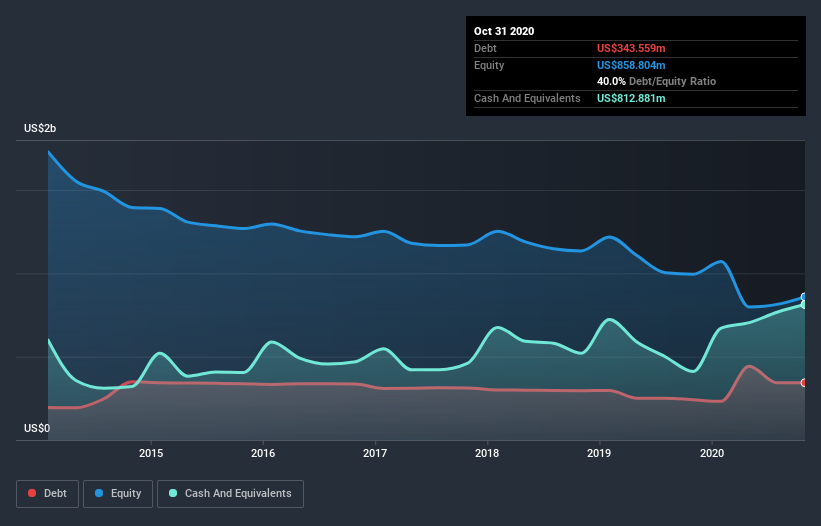Abercrombie & Fitch (NYSE:ANF) Takes On Some Risk With Its Use Of Debt
The external fund manager backed by Berkshire Hathaway's Charlie Munger, Li Lu, makes no bones about it when he says 'The biggest investment risk is not the volatility of prices, but whether you will suffer a permanent loss of capital.' So it might be obvious that you need to consider debt, when you think about how risky any given stock is, because too much debt can sink a company. Importantly, Abercrombie & Fitch Co. (NYSE:ANF) does carry debt. But is this debt a concern to shareholders?
When Is Debt Dangerous?
Generally speaking, debt only becomes a real problem when a company can't easily pay it off, either by raising capital or with its own cash flow. In the worst case scenario, a company can go bankrupt if it cannot pay its creditors. However, a more usual (but still expensive) situation is where a company must dilute shareholders at a cheap share price simply to get debt under control. Of course, the upside of debt is that it often represents cheap capital, especially when it replaces dilution in a company with the ability to reinvest at high rates of return. When we examine debt levels, we first consider both cash and debt levels, together.
View our latest analysis for Abercrombie & Fitch
What Is Abercrombie & Fitch's Net Debt?
The image below, which you can click on for greater detail, shows that at October 2020 Abercrombie & Fitch had debt of US$343.6m, up from US$241.3m in one year. But on the other hand it also has US$812.9m in cash, leading to a US$469.3m net cash position.
How Strong Is Abercrombie & Fitch's Balance Sheet?
Zooming in on the latest balance sheet data, we can see that Abercrombie & Fitch had liabilities of US$953.6m due within 12 months and liabilities of US$1.46b due beyond that. Offsetting these obligations, it had cash of US$812.9m as well as receivables valued at US$89.1m due within 12 months. So it has liabilities totalling US$1.52b more than its cash and near-term receivables, combined.
When you consider that this deficiency exceeds the company's US$1.27b market capitalization, you might well be inclined to review the balance sheet intently. In the scenario where the company had to clean up its balance sheet quickly, it seems likely shareholders would suffer extensive dilution. Abercrombie & Fitch boasts net cash, so it's fair to say it does not have a heavy debt load, even if it does have very significant liabilities, in total.
Shareholders should be aware that Abercrombie & Fitch's EBIT was down 75% last year. If that decline continues then paying off debt will be harder than selling foie gras at a vegan convention. The balance sheet is clearly the area to focus on when you are analysing debt. But it is future earnings, more than anything, that will determine Abercrombie & Fitch's ability to maintain a healthy balance sheet going forward. So if you're focused on the future you can check out this free report showing analyst profit forecasts.
Finally, a company can only pay off debt with cold hard cash, not accounting profits. Abercrombie & Fitch may have net cash on the balance sheet, but it is still interesting to look at how well the business converts its earnings before interest and tax (EBIT) to free cash flow, because that will influence both its need for, and its capacity to manage debt. Happily for any shareholders, Abercrombie & Fitch actually produced more free cash flow than EBIT over the last three years. There's nothing better than incoming cash when it comes to staying in your lenders' good graces.
Summing up
While Abercrombie & Fitch does have more liabilities than liquid assets, it also has net cash of US$469.3m. And it impressed us with free cash flow of US$353m, being 183% of its EBIT. Despite the cash, we do find Abercrombie & Fitch's EBIT growth rate concerning, so we're not particularly comfortable with the stock. The balance sheet is clearly the area to focus on when you are analysing debt. But ultimately, every company can contain risks that exist outside of the balance sheet. Take risks, for example - Abercrombie & Fitch has 3 warning signs (and 1 which is a bit unpleasant) we think you should know about.
Of course, if you're the type of investor who prefers buying stocks without the burden of debt, then don't hesitate to discover our exclusive list of net cash growth stocks, today.
This article by Simply Wall St is general in nature. It does not constitute a recommendation to buy or sell any stock, and does not take account of your objectives, or your financial situation. We aim to bring you long-term focused analysis driven by fundamental data. Note that our analysis may not factor in the latest price-sensitive company announcements or qualitative material. Simply Wall St has no position in any stocks mentioned.
Have feedback on this article? Concerned about the content? Get in touch with us directly. Alternatively, email editorial-team (at) simplywallst.com.

 Yahoo Movies
Yahoo Movies 

